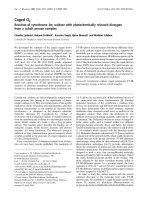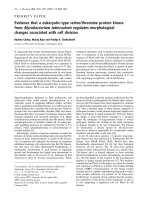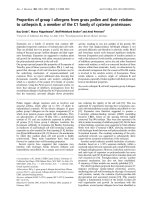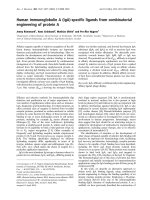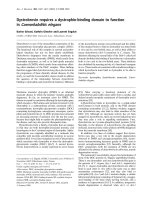Báo cáo y học: "Comparative Hepatology: A journal for all hepatologists with immediate Open Access to quality peer-reviewed research" pptx
Bạn đang xem bản rút gọn của tài liệu. Xem và tải ngay bản đầy đủ của tài liệu tại đây (193.81 KB, 3 trang )
BioMed Central
Page 1 of 3
(page number not for citation purposes)
Comparative Hepatology
Open Access
Editorial
Comparative Hepatology: A journal for all hepatologists with
immediate Open Access to quality peer-reviewed research
Eduardo Rocha*
1
, David E Hinton
2
and Eddie Wisse
3
Address:
1
Laboratory of Histology and Embryology, Department of Microscopy, Institute of Biomedical Sciences Abel Salazar – ICBAS, University
of Porto, Lg. Prof. Abel Salazar n° 2, 4099-003 Porto, Portugal,
2
Duke University, Nicholas School of the Environment and Earth Sciences, Division
of Environmental Sciences and Policy, A-333 LSRC, Science Drive, Box 90328 Durham, North Carolina 27708-0328, United States and
3
Irisweg
16, 3140 Keerbergen, Belgium
Email: Eduardo Rocha* - ; David E Hinton - ; Eddie Wisse -
* Corresponding author
What is Comparative Hepatology?
Comparative Hepatology is an Open Access, peer-reviewed
online journal for liver-oriented research, publishing
basic and applied studies, in biology, veterinary and
human medicine. The journal is published by BioMed
Central.
The journal is a valuable reference forum for publication
of quality original research on the normal or disrupted
anatomy and physiology of the liver, including any of its
supracellular, cellular or subcellular components. It con-
siders articles that deal descriptively or experimentally
with the liver. It also welcomes pathobiology studies.
Translational research reports are encouraged and purely
clinical hepatology is considered especially when it bears
new insights on the structure and function of the liver.
Multidisciplinary approaches (involving diverse expertise
or organs) are welcomed, and articles are acceptable, sub-
ject to peer review, as long as the liver is a major focus of
the study.
Comparative Hepatology is a unique journal in its field,
allowing and encouraging publication of data from liver
research spanning a wide range of scientific interests and
species, as long as the results and conclusions are original
and scientifically justified. The journal naturally brings
together hepatologists with different views, expertise and
particular interests.
Peer review policy
Publication of articles is dependent only on scientific
validity, as judged by Editors and peer reviewers. At least
two experts will review submitted manuscripts.
Key issues for peer reviewers are the methodological rig-
our, whether the work has flaws that should preclude pub-
lication, and whether the results are original and adequate
to support the conclusions drawn.
Authors are requested to suggest peer reviewers; however,
the Editors can choose referees other than, or in addition
to, those suggested.
What Open Access really means for
hepatologists?
Open Access normally applies only to research articles.
Comparative Hepatology however, has taken this further, by
making all of its articles Open Access.
Open Access changes the way in which articles are pub-
lished. First, all accepted articles immediately become
freely and universally accessible online, and so an author's
work can be read by anyone at no cost. Second, the
authors hold copyright for their work and grant anyone
the right to reproduce and disseminate the article, pro-
vided that it is correctly cited and no errors are introduced
[1]. Third, a copy of the full text of each article is perma-
nently archived in an online repository separate from the
journal. Comparative Hepatology articles are archived in
PubMed Central [2], the US National Library of Medi-
Published: 12 February 2004
Comparative Hepatology 2004, 3:1
Received: 20 January 2004
Accepted: 12 February 2004
This article is available from: />© 2004 Rocha et al; licensee BioMed Central Ltd. This is an Open Access article: verbatim copying and redistribution of this article are permitted in all
media for any purpose, provided this notice is preserved along with the article's original URL.
Comparative Hepatology 2004, 3 />Page 2 of 3
(page number not for citation purposes)
cine's full-text repository of life science literature, and also
in repositories at the University of Potsdam [3] in Ger-
many, at INIST [4] in France and in e-Depot [5], the
National Library of the Netherlands' digital archive of all
electronic publications.
Article-processing charges and waivers
Article-processing charges (APCs) are needed to allow
continued Open Access to Comparative Hepatology articles.
Authors are asked to pay the equivalent to US$525 if their
article is accepted for publication. No charge is made for
articles that are rejected after peer review. The Editor-in-
Chief will consider waiver requests on a case-by-case
basis. Discounts equivalent to US$50 are available if
authors submit their manuscript with references handled
and formatted with recommended bibliographic software
(Endnote 5/6 or Reference Manager 10).
Authors can circumvent the charge by getting their institu-
tion to become a 'member' of BioMed Central, whereby
the annual membership fee covers the APCs for all
authors at that institution for that year. This programme
has been a success, and the number of members continues
to increase, and include to this date more than 395 mem-
bers in 32 countries. Current members include, for exam-
ple, the NHS England, the World Health Organization,
the US National Institutes of Health, Harvard, Princeton
and Yale universities, and all UK universities [6]. Funding
agencies have also realized the importance of Open Access
publishing and have specified that their grants may be
used directly to pay APCs [7].
A glance at our first year of publication
Launched in late August 2002, the journal has received
submissions from Africa, Asia, Europe, and United States
of America. From this pool, several manuscripts were
found acceptable and were published. The articles ful-
filled the journal's "comparative" aim, covering a wide
range of species within a broad scope. Reviewers were cho-
sen with utmost care. Our rejection rate was 29%. At least
six indexed articles cited Comparative Hepatology articles,
as currently seen in ISI Web of Knowledge
SM
.
The Proceedings of the 11
th
International Symposium on
the Cells of the Hepatic Sinusoids and their Relation to
Other Cells, comprising 58 articles, were published as a
supplement (January 14
th
). There was a delay in having
them published because the manuscripts (including
images) were not initially prepared for online publishing;
a key aspect in electronic publishing. A relevant aspect was
revealed by the fact that many errors in references would
most likely pass unnoticed in a printed version – online
linking of the majority of references to their PubMed cita-
tions avoided such errors appearing.
Speeding up publication, with a little help from
the authors
From submission to publication in provisional but fully
peer reviewed form, the shortest publication schedule for
an original research article published in this journal was 2
months and 9 days [8]. Such a fast schedule, or shorter, is
what authors might expect when strictly adhering to our
simple submission instructions, and providing fast feed-
back to the Editorial requests. As pointed out by Wheatley
and Grynszpan [9], for exceptionally good articles the
mechanism is in place to achieve remarkable times from
submission to publication; being technically possible to
publish within a day.
Why choose Comparative Hepatology to publish
your research?
To put it simply, there are good reasons for publishing in
Comparative Hepatology, namely:
• electronic publishing with immediate free access for eve-
rybody
• unlimited space, with the possibility to publish addi-
tional material
• color illustrations at no extra cost
• fast and through peer review
• articles published immediately upon acceptance and
soon after listed in PubMed
• authors and their peers are free to print out copies of
their article, email it to colleagues, and post it on the web
because of the BioMed Central copyright and license
agreement.
In the coming years, we expect a steady increase in the
number of submissions and publications. Authors and
their Institutions have been increasingly supportive of the
Open Access model as a viable and quite efficient way to
disseminate the results of quality scientific research. The
Institute of Scientific Information has already given
impact factors for several BioMed Central journals. Com-
parative Hepatology will surely follow this way, supporting
at the same time all BioMed Central efforts in the develop-
ment and implementation of electronic tools that may
allow authors to track and know the dissemination and
impact of their particular Open Access article.
Why not submit your next liver-oriented research article
to Comparative Hepatology? This option will simply assure
that, if published, your work would be disseminated to
the widest possible audience, given that there are no bar-
riers to access. It has been shown that free online articles
Publish with BioMed Central and every
scientist can read your work free of charge
"BioMed Central will be the most significant development for
disseminating the results of biomedical research in our lifetime."
Sir Paul Nurse, Cancer Research UK
Your research papers will be:
available free of charge to the entire biomedical community
peer reviewed and published immediately upon acceptance
cited in PubMed and archived on PubMed Central
yours — you keep the copyright
Submit your manuscript here:
/>BioMedcentral
Comparative Hepatology 2004, 3 />Page 3 of 3
(page number not for citation purposes)
are more highly cited because of their easier availability
[10], thus promoting their real individual impact among
peers and society. To speed up the process, manuscripts
are submitted electronically, using the online submission
system. Full details of how to submit a manuscript are
given in our instructions for authors. Join or keep support-
ing the new era of electronic publishing and Open Access
in hepatology.
References
1. BioMed Central Open Access Charter [medcen
tral.com/info/about/charter]
2. PubMed Central [
]
3. Potsdam [ />]
4. INIST [ />]
5. e-Depot [ />]
6. BioMed Central Institutional Members [med
central.com/inst/]
7. Which funding agencies explicitly allow direct use of their
grants to cover article processing charges? [http:www.human-
resources-health.com/info/faq/apc faq.asp?txt_faq_no=8]
8. Nedredal GI, Elvevold KH, Ytrebø LM, Olsen R, Revhaug A, Smed-
srød B: Liver sinusoidal endothelial cells represents an impor-
tant blood clearance system in pigs. Comp Hepatol 2003, 2:1.
9. Wheatley D, Grynszpan D: Can we speed up the online publish-
ing process? And who will pay for it, anyway? Cancer Cell Int
2002, 2:5.
10. Lawrence S: Free online availability substantially increases a
paper's impact. Nature 2001, 411:521.

